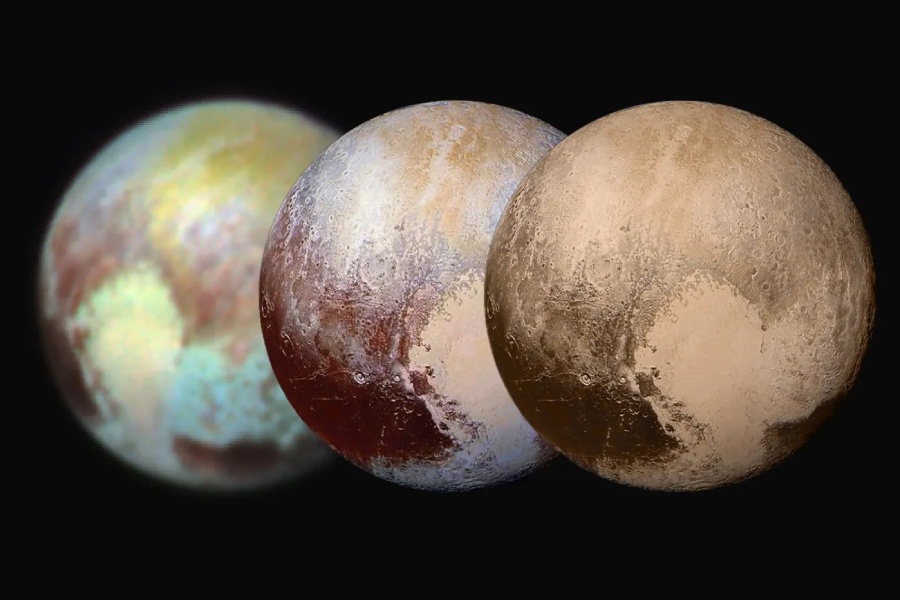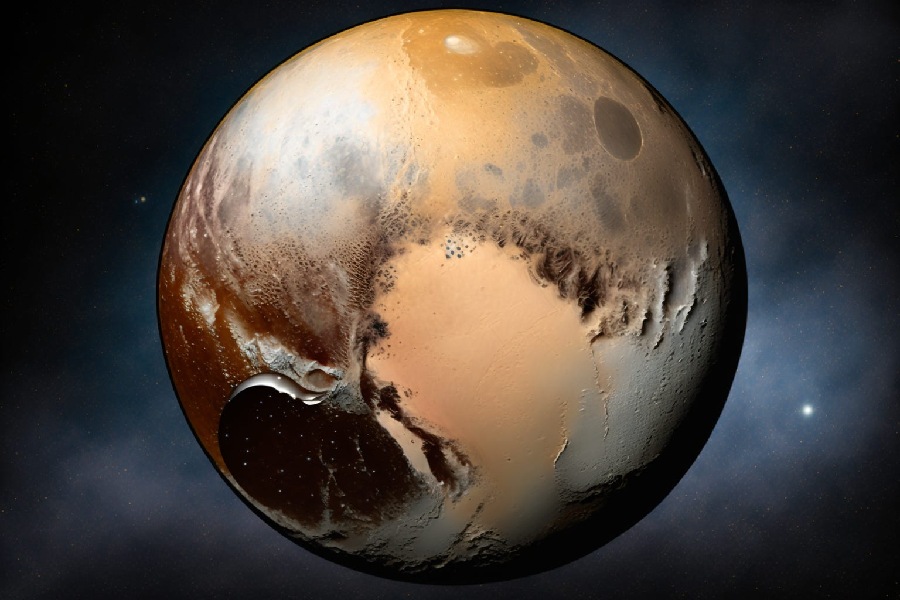In the vast expanse of our Solar System, one celestial body has captured the imagination like no other – Pluto. Often referred to as the “dwarf planet” since its reclassification in 2006, Pluto has remained a source of fascination and intrigue. But what does Pluto look like on the surface?
In this article, we’ll explore what cosmic sights await across the distant surface of Pluto based on the best available evidence. We’ll assess key terrain characteristics revealed by cameras during NASA’s 2015 flyby of Pluto.
Join us on this journey, envisioning alien vistas that may grace the farthest planetary frontier from our Sun.

What Does Pluto Look Like?
Pluto is a small, icy world with a rocky surface, much smaller than Earth. Its surface is covered in frozen nitrogen, methane, and carbon monoxide. From afar, it appears brownish-red due to tholins, complex organic molecules formed in its atmosphere by sunlight.
Its surface shows bright spots and dark patches, hinting at varied composition. Pluto’s appearance offers insight into its intriguing characteristics and history, making it a captivating object in our solar system’s far reaches.
Now, what color is Pluto when looked up close? Is Pluto purple? Let’s explore the surface colors and features of Pluto in the following section.
Physical Characteristics of Pluto
Pluto has an average diameter of 1,475 miles across and is moderately spherical but not fully round. Its mass is only 0.2% of Earth’s mass. Pluto has a 1.9 g/cm3 density, indicating an icy body with around 70% rock mixed with ice. But is Pluto solid all through, or could liquid oceans churn deep beneath the frozen crust?
Pluto’s surface is covered in methane, nitrogen, and carbon monoxide. It also features cratered plains, pits, valleys, ice mountains, and ridges. These suggest a dynamic, geologically-active world despite its small size and cold temperature.
Also, can you walk on Pluto? Or can you stand on Pluto? Walking on Pluto would be extremely challenging due to its harsh conditions. Pluto’s surface temperature averages around -375°F (-225°C), cold enough to freeze most substances solid.
Additionally, Pluto’s surface gravity is only about 6% of Earth’s gravity. This means that even if one could withstand extreme cold, they would weigh significantly less and might find it difficult to move around.
Surface colors
Pluto’s surface exhibits a reddish-brown hue likely caused by complex hydrocarbons called tholins that also give color to Saturn’s moon Titan. Yellowish areas have also been observed, potentially signaling frozen nitrogen. The prominent heart-shaped region called Tombaugh Regio contains ice mountains and glacier-like plains.
Stretching 1,000 miles wide, these strange surface markings on Pluto are remarkable. Among them, Sputnik Planitia stands out with its bright, ice-covered basin spanning 620 miles. Surrounding this basin are nitrogen ice plains, while nearby mountain ranges exhibit signs of glacial flows.
Size and mass
Planetary proportions
Despite being smaller than Earth’s Moon, the dwarf planet Pluto holds the title for the largest known object in the Kuiper Belt. With an average diameter of 1,475 miles and a maximum width of 1,518 miles, it’s about one-fifth the width of our planet.
In terms of mass, Pluto weighs about 1.31 x 10^22 kilograms (approximately 2.89 x 10^22 pounds), which is less than one-tenth of a percent of Earth’s mass. Despite its small size compared to full-fledged planets, Pluto stands out in its outer Solar System neighborhood due to its icy dominance.
Significance of measurements
The precise sizing of Pluto gives key insights into its composition and structure. The dimensions indicate sufficient self-gravitation to collapse into a nearly spherical orb – evidence of geological forces actively molding its shape.
Furthermore, volume combined with mass allows deriving Pluto’s density as 1.9 g/cm3. This density informs models of its composition. It suggests abundant ice content coating a small, inner, dense, rocky core. So, properly weighing and measuring transient Pluto reveals hidden clues illuminating nature.
Dwarf planet ranking
Even though Pluto lost its status as a classic planet in 2006, it remains the largest among dwarf planets in terms of volume. Pluto’s size surpasses rocky Ceres, found in the Asteroid Belt, in sheer bulk and mass. This distinction highlights Pluto’s importance, going beyond just a minor detail.
Its position at the Solar System’s outer reaches adds to its mystique. Beyond Neptune’s orbit lies a new world, existing in perpetual twilight, frozen in time.

Shape and density
Oblate orb
While moderately spherical, frozen Pluto lacks a perfectly round globular shape. Its measurable flattening at the poles yields an oblate spheroid form resembling an oval orange. This results from its faster spin rate, creating an equatorial bulge compared to the slight pinch at the top and bottom axis points.
The uneven mass distribution traces to Pluto’s wobbly orbit. It also traces to chaotic rotation destabilizing its structure. Pluto’s odd shape indicates a significant clue.
Specifically, the dwarf planet lacked internal warmth to relax. It also lacked enough geological activity to become spherical before it froze solid.
Density distribution
Scientists determine the structure inside Pluto by studying its density, gravity, and temperature patterns. The average density worldwide is 1.9 grams per cubic centimeter, indicating a lot of ice.
However, measurements vary, from 1.8 near the center to 2.1 grams per cubic centimeter in rugged, mountainous areas. This suggests that denser rock might be pushing through thinner layers of methane ice.
These uneven measurements support the idea of a core with different chemical compositions. They also hint at a complicated past where materials sank and rose, forming layers of different densities that scientists observe on the surface today.
Geophysical character
Pluto’s oblong shape and varying density result from its intricate geological past. As internal heat dissipated, chemical layers solidified, creating distinct density patterns. This visual representation reflects the evolution of Pluto’s composition as viscosity changed and flexibility diminished.
These observations suggest that Pluto was once a dynamic world. Various processes sculpted its surface, forming shiny ice plains and rugged water ice mountains. Over time, the landscape solidified as temperatures dropped, preserving its features for eons.
These findings raise intriguing questions about Pluto’s past and present. Could there be subsurface oceans hidden beneath its icy crust? How do insulation effects contribute to the existence of liquid water pockets? If such pockets exist, they might provide a habitat for basic life chemistry, even in Pluto’s frigid environment.
Surface features
Heart-shaped Tombaugh Regio
One major surface feature is the prominent heart-shaped structure named Tombaugh Regio, after Pluto’s discoverer. This vast frozen plain, Sputnik Planitia, lies next to cragged ice mountains.
It spans over 600 miles; nitrogen ice flows appear to have flooded the basin, erasing craters. Ongoing convection may reshape the terrain even now, as dramatic color contrasts showcase past geologic activity sculpting the landscape. The peculiar heart shape is theorized to stem from freezing patterns influenced by subsurface liquid lenses and tidal orbital effects straining the dwarf planet’s geology.
Cthulhu Macula
Cthulhu Macula is the name given to a region on Pluto located at its equator. This area has a remarkable presence of striking red organic material. This material covers cracked plains and highlands that stretch approximately 30 miles wide.
The terrain features display distinct flow patterns, suggesting movement. It’s believed that viscous icy sludge carved these patterns across the dim surface before freezing in place.
The unique coloration and flow patterns hint at the possible extrusion of sinking tholin, a complex organic compound. This material might have risen from below the surface in the distant past under conditions where fluids were present.
The appearance of the macula is reminiscent of tentacles as if they were spilling through crustal fissures. This resembles abstract art formed by alien processes on distant celestial bodies.
Snakeskin terrain
A strange formation has been spotted south of Sputnik Planitia, resembling snakeskin with hills and patterned valleys. These features sometimes appear tightly packed together, resembling cells on the icy surface.
They might have been formed by convection in the past, where fluctuations beneath the surface led to the upward movement of material. As this material cooled, it formed clusters of hills.
These unique contours serve as a record of distant events from Pluto’s ancient era. It’s easy to overlook a crucial aspect of Pluto’s history: it was once likely an ocean world teeming with prebiotic chemistry during the early days of the Solar System.
Conclusion
What does Pluto look like? Pluto, once a distant enigma, has revealed itself as a dynamic world of stunning diversity. NASA unveiled its reddish-brown surface, adorned with intriguing features like the heart-shaped Tombaugh Regio, the striking Cthulhu Macula, and the peculiar Snakeskin terrain.
Despite its reclassification, Pluto remains a focal point of scientific curiosity, offering insights into the outer reaches of our Solar System’s evolution. Its oblong shape, varied density, and geophysical characteristics hint at a complex geological past, sparking questions about its history and potential for subsurface oceans.
As exploration continues, Pluto serves as a reminder of the vast mysteries awaiting discovery beyond our home planet. It inspires continued exploration and wonder in the depths of space.
